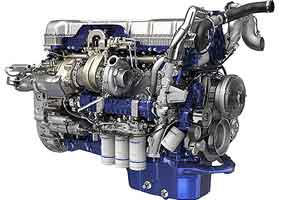Volvo Introduces New Engine, Powertrain Enhancements

For the engine, the 11-liter and 13-liter models, known as D11 and D13, were rolled out in addition to the D13 with turbo compounding during a tour here of the engine and powertrain plant. Fuel-efficiency improvements were reported at 2.2% for the D11, 2.5% for the D13 and 6.5% for the model with turbo compounding, when compared with previous generation engines.
“Volvo engineered multiple engine enhancements to provide customers with the needed fuel savings without sacrificing power and performance,” Volvo Trucks North America President Göran Nyberg said in a statement.
The 11-liter enhancements include a common-rail fuel system designed for quieter operations. Other upgrades are new wave pistons, a two-speed coolant pump, two-piece valve cover, higher horsepower and an assembled camshaft.
Together, they are meant to replicate performance of earlier generation 13-liter engines. January 2017 availability is targeted for the 11-liter engine, a statement said. Horsepower is being increased nearly 5% to 425.
The D13 model, targeted for shorter-distance services such as pickup and delivery runs, offers enhancements similar to the 11-liter, including 6% higher torque, giving drivers more freedom in downspeeding. Availability is planned for October.
The model with turbo compounding is designed for highway operation. It converts wasted exhaust heat into 50 additional horsepower, which is transferred back into the engine, John Moore, marketing product manager, said during the tour of the plant.
The model with turbo compounding, slated for availability in mid-2017, is designed to cruise at 300 rpm less than today’s typical truck, said Wade Long, director of product marketing. One percentage point of that turbo compounding improvement is tied to a driveline with a 2.47 rear axle ratio.
Moore estimated the potential savings using turbo compounding at $231,000 annually for a 75-truck fleet running 125,000 miles per vehicle at 7 mpg, assuming $2.65 per gallon for diesel.
In addition, Volvo is beginning production on the D16, a 16-liter engine targeted to heavy-haul and vocational fleets, offering as much as 600 hp and up to 2,050 pound-feet of torque. Production of the D16 will begin in January.
 I-Shift with Crawler Gears/Volvo Trucks North America
I-Shift with Crawler Gears/Volvo Trucks North AmericaAt the same time the new products were announced, Nyberg described 2016 “as a new year with new challenges."
"We see a softer year ahead of us. The first quarter has been extra soft, but we still expect to have one of the better [sales] years in North America," Nyberg said.
“We are not stopping at engines,” said Long, explaining that I-Shift “crawler gears” will be available on the D16. The new gearing is designed to improve fuel efficiency during slow-speed paving and pouring of concrete.
Another change is replacement of a two-box exhaust aftertreatment with a one-box approach that is designed to speed maintenance.
“These new Volvo powertrain enhancements incorporate our innovative engineering and technology expertise with our focus on meeting customers’ needs to offer them the best possible solutions for the best possible return on investment,” Nyberg said.
Operations also are being enhanced by the U.S. introduction next year of a predictive cruise control technology known as I-See, which Moore said was designed to consistently maximize fuel efficiency, since drivers’ performance varies during a shift. The feature that works together with the I-Shift transmission is designed to store the topography for 4,500 hills. The intent, he said, is to find the right combination of gearing and power for climbing, cresting and rolling downhill.
“Drivers are now going to get more power for less fuel spent,” Moore said.
The latest announcements also focused on weight reductions, such as 17 pounds less for the one-box exhaust aftertreatment system.




